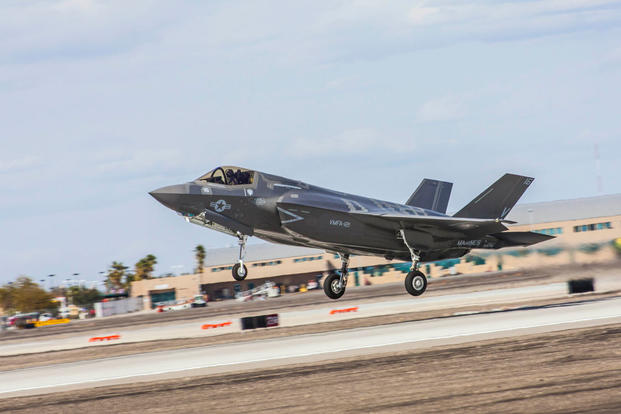Senior Marine Corps leaders hope the entry of the F-35B Joint Strike Fighter into the fleet will change not just the way Marines fly, but the way the force fights as a whole.
And they're planning to test out ways the fifth-generation jet can transform the force by pairing it with an unlikely partner: ground-pounders from the Corps' experimental infantry battalion.
The unit, 3rd Battalion, 5th Marines, out of Camp Pendleton, California, will team up with Yuma-based Marine Fighter Attack Squadron 121 for a variety of training evolutions before the units deploy together to the Pacific with the 31st Marine Expeditionary Unit next year.
These smaller-scale training efforts will give Marines insight into how the aircraft can improve ground combat operations, Lt. Gen. Robert Walsh, head of Marine Corps Combat Development Command, told Military.com in a recent interview.
"We'll get them together now and start operating together, and start to wring out ideas about how you can use the F-35 differently," he said. "Because when you finally get aboard the [amphibious assault ship] USS Wasp together, you already have started to figure, they can do some groundbreaking stuff with the capabilities we're going to bring into 3/5, technology-wise."
Commandant Gen. Robert Neller designated 3/5 as the Corps' experimental unit at the beginning of this year, an unconventional move that highlights the service's heightened interest in rapid prototyping and acquisition and its evolving perspective on force employment for future conflicts.
The unit has been instrumental in testing new gear and different unit sizes and structure, efforts that will continue in the coming year and beyond. But the fact that the battalion is set to accompany the Corps' F-35s on their first deployment owes something to serendipity.
"We stumbled upon it," Walsh said. "But we're going to use and leverage that."
One effort will focus on Link 16, the sophisticated military tactical exchange network used by the F-35 and a number of other U.S. air platforms. Walsh wants to try giving ground troops hand-held smart devices connected to the Link 16 network that could potentially deliver real-time data and situational information from airborne Joint Strike Fighters.
It's a capability that the Air Force might not be interested in for its aircraft, Walsh said, but it has potential for the ground-heavy Marine Corps force.
"Because we're on the front edge of this, linking together 3/5, that you're going to have this great sensing capability that's going to be out there flying," he said. "We want to start getting real-time capability off that airplane … so LINK 16 is a way we know we can get it off."
Walsh also hopes to send battalion forward air controllers, joint terminal attack controllers, and others who coordinate with aircraft in their roles to spend time with VMFA-121 and Marine Operational Test and Evaluation Squadron 1 in Yuma to participate in aircraft exercises and pre-deployment activities.
With both the battalion and the squadron currently stateside, he said, these smaller detachments can engage in conversations between air and ground counterparts about the F-35's capabilities.
"Get them into those units, get them smart on what the F-35 can do, and start pulling together," Walsh said. "It doesn't have to be the whole battalion; it can be bits and pieces starting to work together more."
VMFA-121 is set to depart for Okinawa, Japan, in January, the first Marine F-35 squadron to be forward based. The squadron is expected to deploy aboard the 31st MEU sometime in the fall.
And within the same year, the Marine Corps plans to deploy another F-35 squadron aboard the Essex Amphibious Ready Group, an outing that will likely represent the aircraft's first opportunity to support counter-Islamic State operations in the Middle East.
-- Hope Hodge Seck can be reached at hope.seck@military.com. Follow her on Twitter at@HopeSeck.
Related Video:
Bullet Points: F35 Lightning II



























